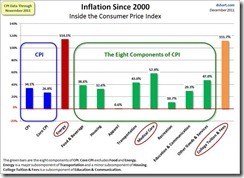Chris Mayer at the Daily Reckoning explains why we should not rely on mainstream news as source for decision making (bold emphasis mine)
Dobelli’s analogy with food is a good one. We know if you eat too much junk food, it makes us fat and can cause us all kinds of health problems. Dobelli makes a good case that the mind works the same way. News is brightly colored candy for the mind.
News is systematically misleading, reporting on the highly visible and ignoring the subtle and deeper stories. It is made to grab our attention, not report on the world. And thus, it gives us a false sense of how the world works, masking the truer probabilities of events.
News is mostly irrelevant. Dobelli says to think about the roughly 10,000 news stories you’ve read or heard over the past year. How many helped you make a better decision about something affecting your life? This one hit home…
We get swamped with news, but it is harder to filter out what is relevant — which gets me to another point that hit home. Dobelli talks about the feeling of “missing something.” When traveling, I sometimes have this feeling. But as he says, if something really important happened, you’d hear about it from your friends, family, neighbors and/or co-workers. They also serve as your filter. They won’t tell you about the latest antics of Charlie Sheen because they know you won’t care.
Further, news is not important, but the threads that link stories and give understanding are. Dobelli makes the case that “reading news to understand the world is worse than not reading anything.” In markets, I find this is true. The mainstream press has little understanding of how markets work. They constantly report on trivia and make links where none exist for the sake of a story, or just for the sake of having something that “makes sense.”
In markets, reporters try to explain the market every day. “The market falls on Greek news” is an example. Better to not read anything if you’re going to take this kind of play-by-play seriously at all.
The fact is we don’t know why lots of things happen. We can’t know for sure why, exactly, things unfolded just as they did when they did. As Dobelli writes, “We don’t know why the stock market moves as it moves. Too many factors go into such shifts. Any journalist who writes, ‘The market moved because of X’... is an idiot.”
You contaminate your thinking if you accept the neat packages news provides for why things happen. And Dobelli has all kinds of good stuff about how consuming news makes you a shallow thinker and actually alters the structure of your brain — for the worse.
News is also costly. As Dobelli points out, even checking the news for 15 minutes three times a day adds up to more than five hours a week. For what? He uses the example of the Mumbai terror attacks in 2008. If a billion people spent one hour of their attention on the tragedy by either reading about it in the news or watching it, you’re talking about 1 billion hours. That’s more than 100,000 years. Using the global life expectancy of 66 years means the news consumed nearly 2,000 lives!
Pretty wild, right?
So what to do? Dobelli recommends swearing off newspapers, TV news and websites that provide news. Delete the news apps from your iPhone. No news feeds to your inbox. Instead, read long-form journalism and books. Dobelli likes magazines like Science and The New Yorker, for instance.
News and analysis from the mainstream usually represents oversimplified narration of facts that has been typically grounded from cognitive biases (heuristics) and logical fallacies.
Also because news outfits are profit based businesses, their presentations are often designed to generate or to solicit public’s attention through sensationalist reporting or through supposed “analytical” discussions mostly predicated on the emotive dimensions.
Moreover because news outfits have enormous influence on voters, they have embedded ties with the establishment as they reciprocate each other in projecting "noble"political goals. Thus media's bias has been to promote the establishment's interests and frequently serve as discreet channels for political propaganda.
Noticeably most of their arguments have been focused on personality issues rather than the objective evaluation of the system.
Yet their basic recourse to any social problem would be to: 1) change the leader, 2) throw money at the problem, 3) prohibit or intervene on any supposed social ills or 4) tax particular groups. No one ever sees how their proposed interventionism creates more problems which they intend to resolve.
Except for the facts I usually refrain from reading or listening to any of their stupefying analysis.
And I firmly agree with Mr. Dobelli who is quoted above saying “reading news to understand the world is worse than not reading anything”. I’d rather be dumb than be indoctrinated with a quack view of the world.






















